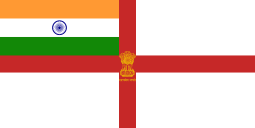PNS Zulfiqar (K265)
| History | |
|---|---|
| Name: | HMS Deveron |
| Builder: | Smith's Dock Co Ltd |
| Laid down: | 16 April 1942 |
| Launched: | 12 October 1942 |
| Commissioned: | 2 March 1943 |
| Fate: | Transferred to India as HMIS Dhanush in 1945 |
| Name: | HMIS Dhanush |
| Commissioned: | 1945 |
| Decommissioned: | 1947 |
| Fate: | Transferred to Pakistan as PNS Dhanush |
| Name: | PNS Zulfiqar |
| Identification: | Pennant number: F265 changed to F262 in 1963 |
| Fate: | Damaged beyond repair December 1971 |
| General characteristics | |
| Class and type: | River-class frigate |
PNS Zulfiqar was a River-class frigate of the Pakistan Navy, originally built for the Royal Navy during the Second World War as HMS Deveron. Zulfiqar was damaged beyond repair by friendly fire from aircraft of the Pakistan Air Force which mistook her for a missile boat of the Indian Navy during the Indo-Pakistani War of 1971.[1]
History
Following service in the Second World War Deveron was transferred to the Royal Indian Navy in 1945 and was renamed HMIS Dhanush.[2] On Partition she was transferred to the Royal Pakistan Navy and converted into a survey vessel, as well as being renamed Zulfiqar.[3] The conversion meant the rear 4-inch gun was removed. Her pennant number was changed from F265 to 262 in 1963.[4]
In June 1953 she attended the Coronation Review of Queen Elizabeth II at Spithead.[5]
She was decommissioned in 1983.
Operation Trident
The Pakistan Navy, on high alert as a result of the Operation Trident, raised a number of false alarms in the ensuing days about the presence of Indian Navy vessels off Karachi. One such false alarm was raised by a PIA Fokker Friendship reconnaissance aircraft carrying naval observers, in the early hours of 6 December 1971 which reported a Pakistan Navy frigate as a missile boat of the Indian Navy, in the area west of Cape Monze on the Pakistani coast.[1] The Pakistan Air Force, giving air support to the Pakistan Navy at Karachi, had received the report. Clearance was given to attack by Cdre Bhombal from the Pakistan Navy.[1]
At 0645 hrs, fighter jets were scrambled which strafed the vessel before it was identified as the Pakistan Navy's own frigate Zulfiqar. During the aerial attack Zulfiqar was hit by more than 900 rounds of .50 caliber ammunition, killing several officers and men, with many more injured.[6] The air attack on Zulfiqar was halted after frantic efforts by her crew to identify their ship as a Pakistani naval vessel finally succeeded.[1]
The whole incident was monitored by the Indian Navy on radio and revealed the following points: First, the incorrect identification and attack happened in spite of Zulfiqar being anchored. This showed that PAF pilots could not clearly distinguish a frigate from a missile boat. Second, it showed the fear that the PN had of India's missile boats.
This incident vindicated the decision to proceed with Operation Python, which was being debated after a PAF attack on Okha on the night of 5/6 Dec 71. It also prompted the Pakistan Navy to withdraw the Pakistani fleet closer to the Pakistani shore.[1]
References
- 1 2 3 4 5 "Trident, Grandslam and Python: Attacks on Karachi". Archived from the original on 26 September 2009.
- ↑ "HMS Deveron (K265". www.uboat.net. Archived from the original on 20 June 2010. Retrieved 22 November 2014.
- ↑ "HMS Deveron (K265)". teesbuiltships.co.uk. Retrieved 22 November 2014.
- ↑ Raymond V B Blackman (ed.). Jane's Fighting Ships 1963-4,. London: Sampson Low, Marston & Co. Ltd,. p. 195.
- ↑ Souvenir Programme, Coronation Review of the Fleet, Spithead, 15th June 1953, HMSO, Gale and Polden
- ↑ "DEFENCE NOTES". defencejournal.com. Archived from the original on 1 January 2012. Retrieved 25 April 2012.
Publications
- Colledge, J. J.; Warlow, Ben (2006) [1969]. Ships of the Royal Navy: The Complete Record of all Fighting Ships of the Royal Navy (Rev. ed.). London: Chatham Publishing. ISBN 978-1-86176-281-8. OCLC 67375475.
